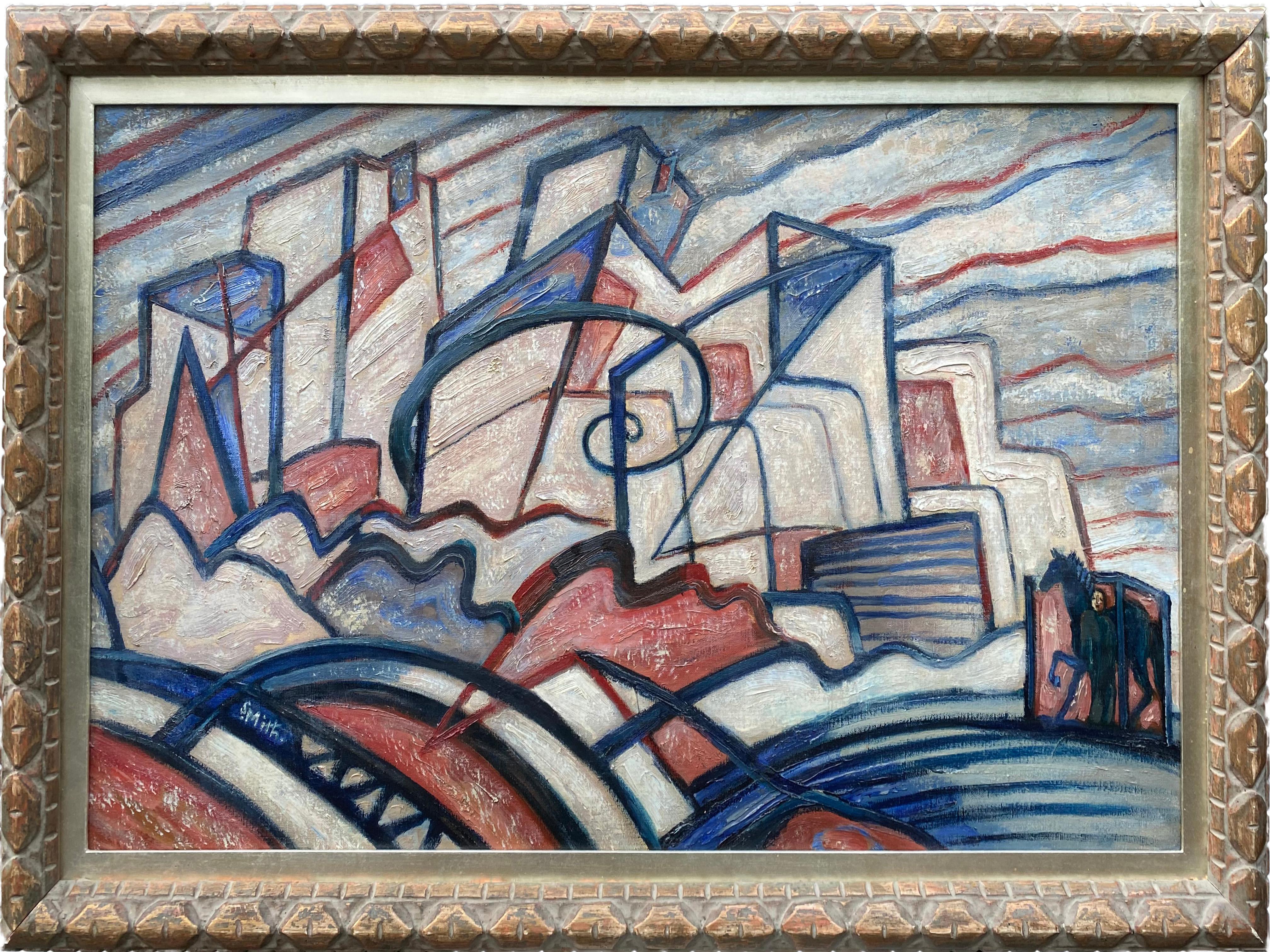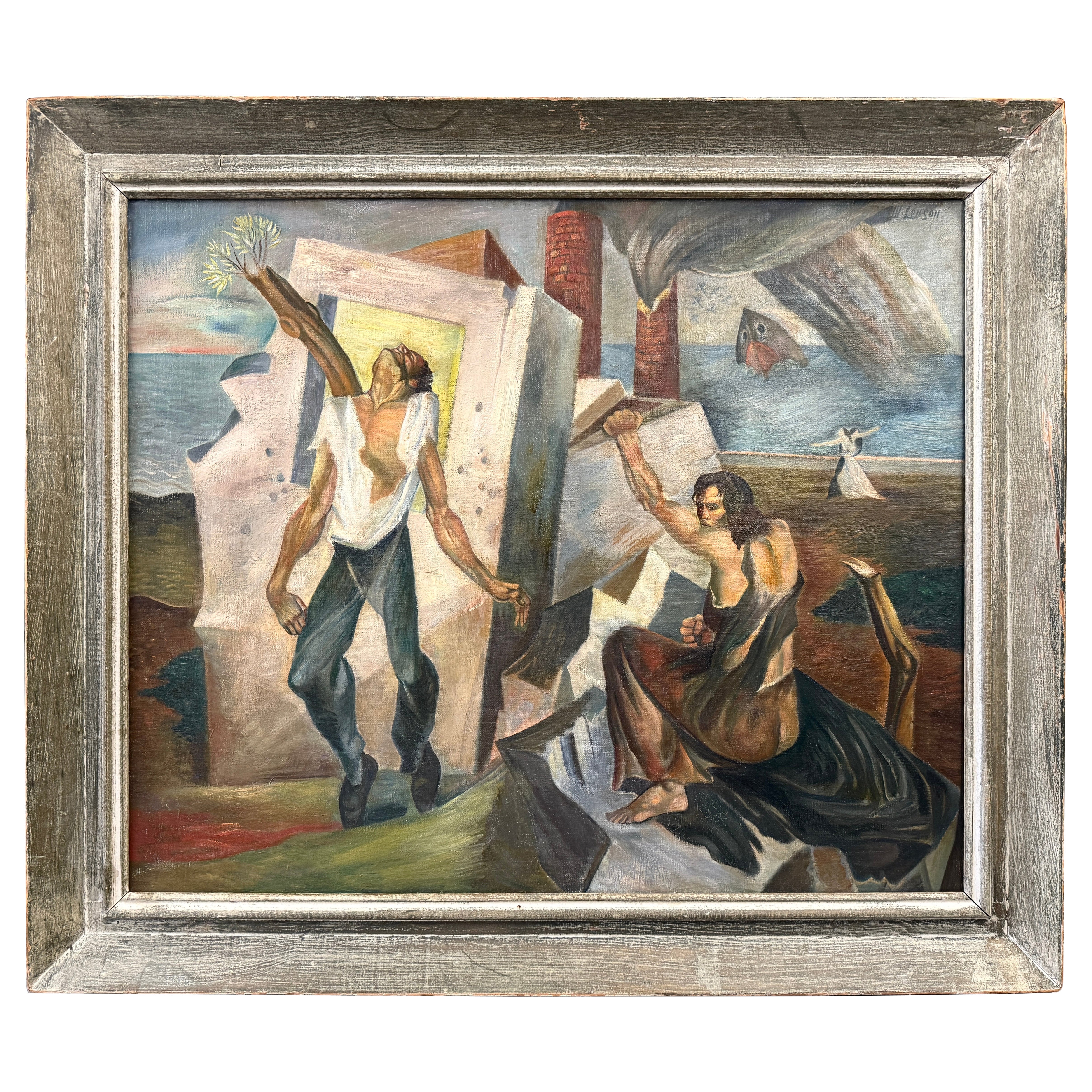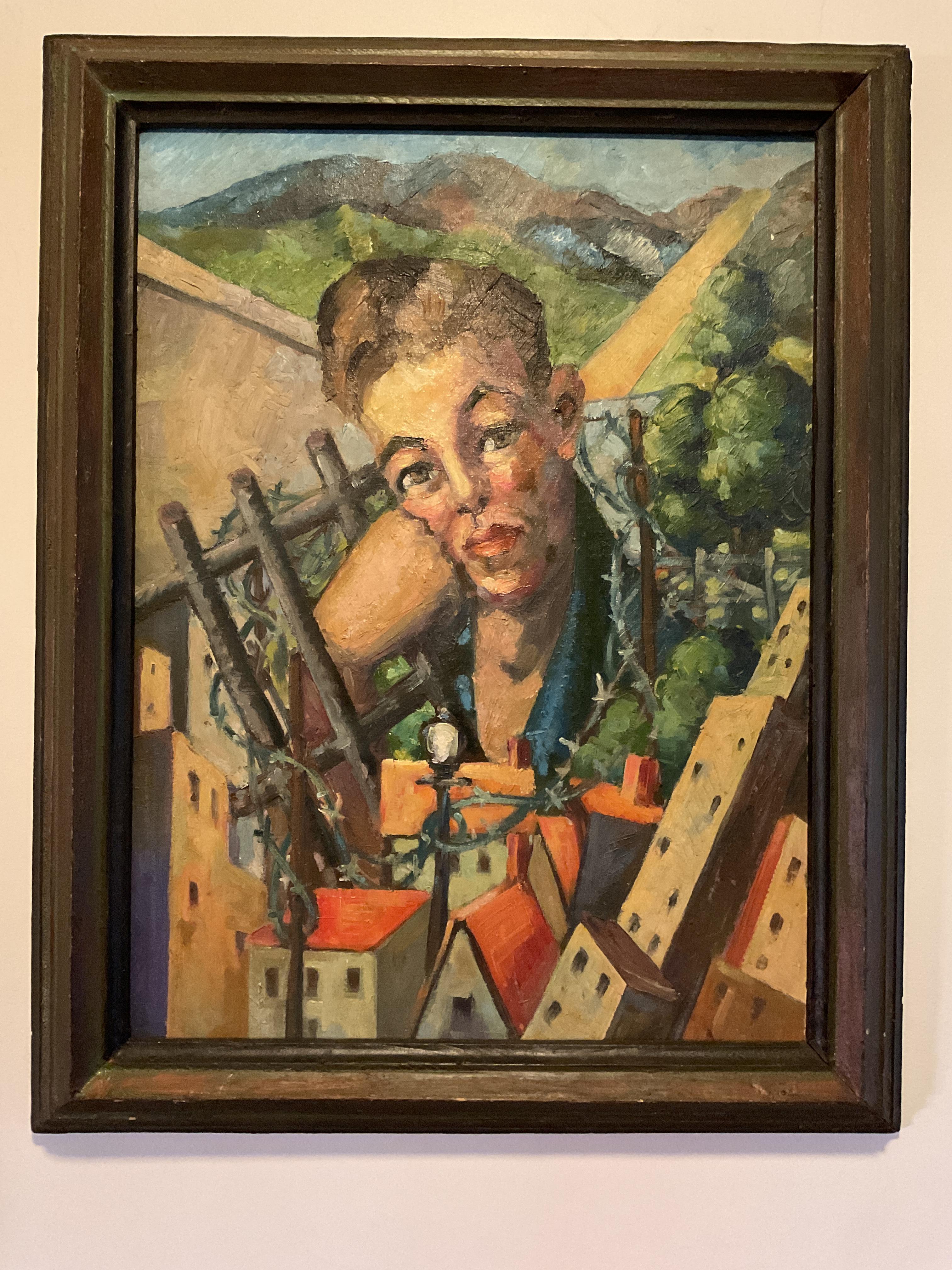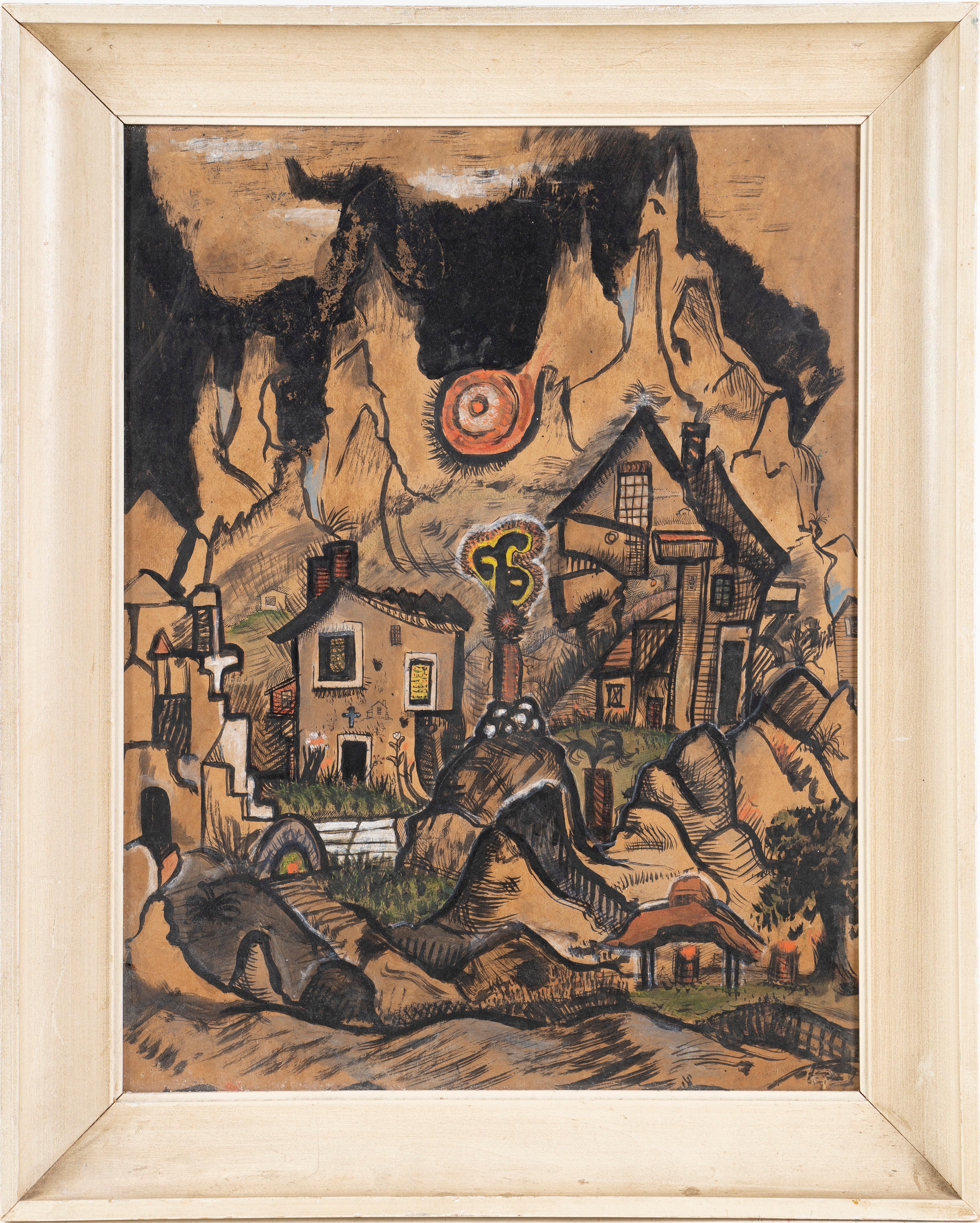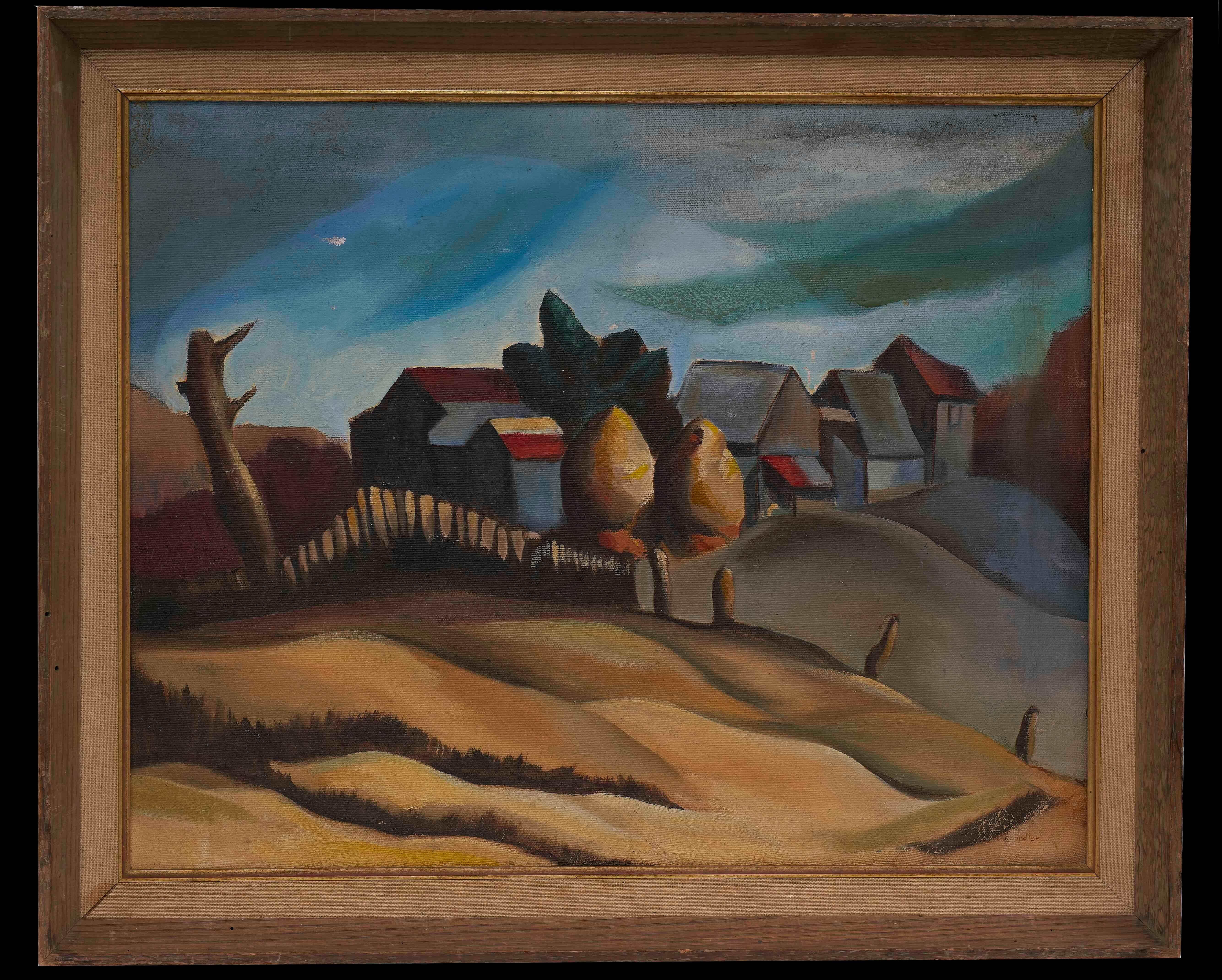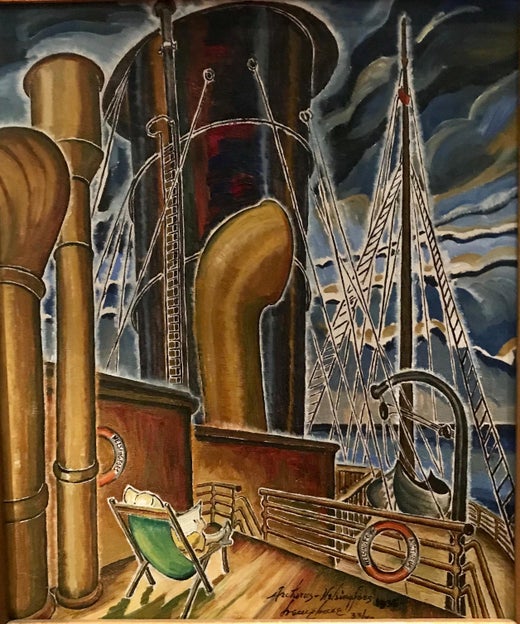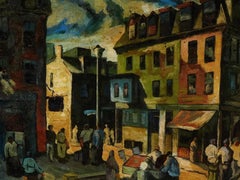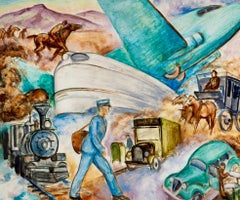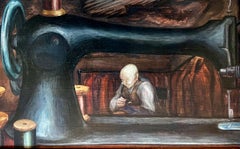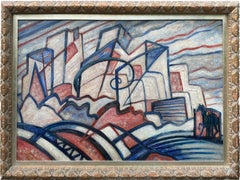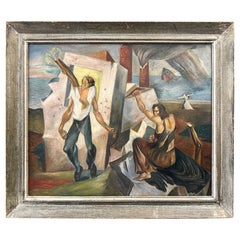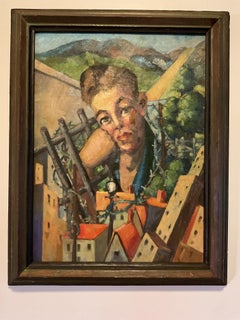Items Similar to "Arcturus, Helsing" Modern Oil Painting WPA American Scene Denver Historical Art
Want more images or videos?
Request additional images or videos from the seller
1 of 9
Eve Drewelowe"Arcturus, Helsing" Modern Oil Painting WPA American Scene Denver Historical Art1935
1935
$30,000
£22,659.12
€26,187.42
CA$42,079.59
A$46,803.31
CHF 24,495.85
MX$570,846.06
NOK 307,799.28
SEK 289,524.96
DKK 195,463.62
About the Item
"Arcturus, Helsingfors," 19 x 16 inches, oil on canvas, signed, titled and dated 1935, 33/30C lower right.
Provenance: Acquired from the personal collection of Jim Elkind (Lost City Arts) who acquired it from interior designer Jay Spector. Graham Gallery label on verso.
Born in New Hampton, Iowa, Eve Drewelowe graduated from Hampton High School in 1919 and then studied at the University of Iowa in Iowa City. She earned a Bachelor of Arts degree (Graphic and Plastic Arts). Drewelowe went on to become the first recipient of a Masters of Painting degree at the University of Iowa in 1924.
During nearly seven decades as an artist, from age twenty-one until her death at age eighty-nine–working in impressionist, social realist and abstract expressionist styles–Drewelowe executed more than one-thousand works in oil, watercolors, pen and ink, and other media.
Drewelowe had one-person exhibitions at the University of Colorado, 1930; the Denver Art Museum, 1933, 1936, 1939; and the Argent Galleries, New York, 1940, 1941. Other exhibitions included the Denver Art Museum; Joslyn Art Museum, Omaha; Kansas City Art Institute; PAFA; AIC; New York World’s Fair; NAWA; and NMWA.
Drewelowe’s works are found in the collections of the University of Colorado; University of Iowa School of Art and Art History, Iowa City; Harkness House, London; and Utah State University, Logan.
The images measure 19 x 16 inches and the framed work is 24 x 21 inches
- Creator:Eve Drewelowe (1899 - 1989, American)
- Creation Year:1935
- Dimensions:Height: 24 in (60.96 cm)Width: 21 in (53.34 cm)Depth: 2 in (5.08 cm)
- Medium:
- Movement & Style:
- Period:
- Condition:
- Gallery Location:New York, NY
- Reference Number:1stDibs: LU115624140932
Eve Drewelowe
From her earliest memory, Eve Drewelowe wanted to be an artist, and she became the first student to receive a masters of fine arts from the University of Iowa. After graduation, she went with her new husband to Boulder, Colorado, where she soon found herself in the role of dean’s wife. Eventually that responsibility and its “chores” proved to be too restrictive. After a health crisis, Drewelowe had a self-described “reincarnation” in which she resolved to make a place for her creativity. Naturally effusive, she yet valued being alone, and her strong feelings for life were expressed in her exuberant paintings. Growing up on an Iowa farm, Drewelowe developed a love for the land from her “environmentalist” father, who died when she was eleven. Subsequently, The Dean of the Graduate School at Iowa served as a father-figure when he facilitated her entry into the graduate program in art. Seemingly skeptical, Carl Seashore secretly wanted the young woman to “establish a first in the history of art training across the nation,” as the artist would later reminisce. Drewelowe graduated in 1924, and she later was a benefactor of what became one of the nation’s leading college art programs. At college, Drewelowe met and married a political science student, Jacob van Ek. Accepting a teaching position at the University of Colorado, van Ek moved to Boulder with his bride, who pursued her interest by helping found the Boulder Artists’ Guild. In 1928-1929, they traveled around the world to twenty-three countries for thirteen months, during which Drewelowe filled seven sketchbooks. With her husband now a dean, she threw herself into remodeling their house, a domestically acceptable creative project. Balancing her art and her duties as a dean’s wife, Drewelowe felt increasing frustration, and her health began to suffer. In the catalogue of a 1988 retrospective, she gave voice to her desire for self-determination: “Housewife! What an odious word! First! Foremost! Always! My waking thought from an embryo was on my need to be an artist!” Traveling to New York for her second solo exhibition in 1940, she stopped at the Mayo Clinic, where she was diagnosed as having a gastric polyp. This experience led to a new dedication to her painting, a complete turnaround in which she called her “reincarnation.” Inspired by the Rocky Mountains, she painted animated landscapes that pulsated with energy -- as if still in motion from generative forces. With a rainbow palette, Drewelowe created visionary scenes by intensifying colors in lively, rippling patterns. ©David Cook Galleries, LLC
About the Seller
5.0
Gold Seller
Premium sellers maintaining a 4.3+ rating and 24-hour response times
Established in 2008
1stDibs seller since 2019
195 sales on 1stDibs
Typical response time: <1 hour
- ShippingRetrieving quote...Shipping from: New York, NY
- Return Policy
Authenticity Guarantee
In the unlikely event there’s an issue with an item’s authenticity, contact us within 1 year for a full refund. DetailsMoney-Back Guarantee
If your item is not as described, is damaged in transit, or does not arrive, contact us within 7 days for a full refund. Details24-Hour Cancellation
You have a 24-hour grace period in which to reconsider your purchase, with no questions asked.Vetted Professional Sellers
Our world-class sellers must adhere to strict standards for service and quality, maintaining the integrity of our listings.Price-Match Guarantee
If you find that a seller listed the same item for a lower price elsewhere, we’ll match it.Trusted Global Delivery
Our best-in-class carrier network provides specialized shipping options worldwide, including custom delivery.More From This Seller
View AllCityscape Mid-20th Century Modern Social Realism American Scene Regionalism WPA
Located in New York, NY
Cityscape Mid-20th Century Modern Social Realism American Scene Regionalism WPA
Samuel Thal (1903 to 1964)
"Cityscene"
12 x 16 inches
Oil on board, c. 1940s
Signed verso
Framed: 19...
Category
1940s American Modern Figurative Paintings
Materials
Board, Oil
"History of US Postal Service" American Scene Social Realism WPA Modern Chicago
By Harold Haydon
Located in New York, NY
"History of US Postal Service" American Scene Social Realism WPA Modern Chicago
Harold Haydon
"History of the U.S. Postal Service"
21 x 25 1/2 inches
O...
Category
1930s American Modern Figurative Paintings
Materials
Canvas, Oil
"Tailor" WPA American Scene Social Realism Modernism Mid Century Modern Fashion
By Mervin Jules
Located in New York, NY
"Tailor" WPA American Scene Social Realism Modernism Mid Century Modern Fashion
Mervin Jules (1912 – 1994)
"The Tailor"
9 1/2 x 15 1/2 inches
Oil on masonite, c. 1930s
Signed lower ...
Category
1930s American Modern Figurative Paintings
Materials
Oil, Board
NYC Cityscape American Scene WPA Modern Realism Mid 20th Century Architectural
By Ernest Fiene
Located in New York, NY
NYC Cityscape American Scene WPA Modern Realism Mid 20th Century Architectural
Ernest Fiene (1894-1965)
Cityscape
36 x 30 inches
Oil on canvas
Signed and dated 1930. lower right
Provenance
Estate of the artist.
ACA Galleries, New York
Exhibited
New York, Frank Rehn Gallery, Changing Old New York, 1931.
New York, ACA Galleries, Ernest Fiene: Art of the City, 1925-1955, May 2-23, 1981, n.p., no. 5.
BIO
Ernest Fiene was born in Elberfeld, Germany in 1894. As a teenager, Fiene immigrated to the United States in 1912. He studied art at the National Academy of Design in New York City from 1914 to 1918, taking day classes with Thomas Maynard and evening classes with Leon Kroll. Fiene continued his studies at the Beaux-Arts Institute of Design in New York from 1916 to 1918, adding classes in printmaking at the Art Students League in 1923.
Fiene began his career as an artist in 1919 with his first exhibition of watercolors at the MacDowell Club arranged by his mentor Robert Henri. In 1923 the Whitney Studio Club mounted a large exhibition of his works. The following year he had an exhibition at the New Gallery in New York, which completely sold out all fifty-two works, including paintings, watercolors, drawings, and etchings. With the proceeds of sales from the New Gallery exhibition, Ernest Fiene and his younger brother Paul, a sculptor, built studios in Woodstock, New York in 1925.
In the early Twenties Ernest Fiene painted mostly landscapes of Woodstock and both the Ramapo and Hudson River Valleys. The first monograph from the Younger Artists Series was published on Fiene in 1922. Published in Woodstock, the series went on to include Alexander Brook, Peggy Bacon, and Yasuo Kuniyoshi. The book reproduced 1 illustration in color and another 27 reproductions in black and white. Around 1925 Fiene became fascinated with the intensity, excitement, and opportunities for color harmonies New York City offered as a subject. His paintings shifted to urban and industrial themes with architecture, industry, and transportation becoming his subjects.
By 1926 Fiene had attracted the dealer Frank K.M. Rehn, who gave him a one-man exhibition that year, which travelled to the Boston Arts Club. C.W. Kraushaar Galleries gave Fiene a one-man exhibition of urban, landscape, portrait, and still life paintings in 1927. Julianna Force, the director of the Whitney Studio Club and first director of the Whitney Museum of American Art, included two of Fiene’s paintings in a fall exhibition in 1928. The Whitney Studio Club showed Fiene’s paintings in a two-man exhibition with Glenn O. Coleman that year and acquired three of Fiene’s paintings. Also in 1928 Fiene became affiliated with Edith Halpert’s Downtown Gallery where he had an exhibition of 20 lithographs in the spring. Fiene sold his house in Woodstock in 1928 to spend more of his time in New York City.
With so many successful exhibitions, Fiene returned to Paris in 1928-29 where he rented Jules Pascin's studio and studied at the Académie de la Grande Chaumière. In France, Fiene painted both landscape and urban subjects developed from ideas influenced by Cubist geometry and the use of flat areas of broad color. Upon returning to New York in 1930, Fiene used this new approach to continue to paint New York skyscraper and waterfront subjects, as well as to begin a series of paintings on changing old New York based on the excavations for Radio City Music Hall and the construction of the Empire State Building. Frank K.M. Rehn Galleries exhibited this series, titled “Changing Old New York,” in 1931. Fiene also has solo exhibitions at Rehn Galleries in 1930 and 1932. Fiene’s oil paintings are exhibited at the Chicago Arts Club in 1930 as well.
Fiene was included in the Museum of Modern Art’s exhibition Painting and Sculpture by Living Americans in December of 1931. Visiting New York, Henri Matisse saw the exhibition and called Fiene’s Razing Buildings, West 49th Street the finest painting he had seen in New York. Fiene had two mural studies from his Mechanical Progress series exhibited at the Museum of Modern Art’s exhibition Murals by American Painters and Photographers in 1932. Fiene sent View from my Window which depicts Fiene working on a lithograph stone while looking out his window to the newly completed Empire State Building to the Carnegie International in 1931. In 1932 Fiene participated in the first Biennial of American Painting at the Whitney Museum and his prints were included in exhibitions at the Downtown Gallery and the Wehye Gallery. In the same year, Fiene was awarded a Guggenheim fellowship to further study mural painting in Florence, Italy.
On his return from Italy in 1933 Fiene re-engaged himself in New York City life and won several public and private mural projects. Fiene resumed his active exhibition schedule, participating in two group exhibitions at the Whitney Museum and a one-man exhibition of recent paintings at the Downtown Gallery in January 1934. In 1933 he purchased a farm in Southbury, Connecticut, which added Connecticut scenes to his landscape subjects. This was also the year Fiene began to spend summers on Monhegan Island, Maine, where he painted seascapes, harbor scenes, and still lifes.
Fiene’s landscape paintings attracted numerous commissions as part of the American Scene movement. Through the fall and winter of 1935-36, Fiene took an extended sketching trip through the urban, industrial, and farming areas of Pennsylvania and West Virginia. Most of the twenty-four Pennsylvania urban and rural paintings...
Category
1930s American Modern Landscape Paintings
Materials
Canvas, Oil
"Two Seas and a Moon" Surrealism American Scene WWII Modern WWI Denver WPA Era
By Arnold Rönnebeck
Located in New York, NY
"Two Seas and a Moon" Surrealism American Scene WWII Modern WWI Denver WPA Era
Arnold Ronnebeck (1885 - 1947)
Two Seas and a Moon
30 x 22 1/2 inches
Oil on Canvas, c. 1943
Signed u...
Category
1940s Surrealist Figurative Paintings
Materials
Canvas, Oil
WWI American Scene Ashcan Modern 20th Century Historical Realism Industrial WPA
By Gerrit Beneker
Located in New York, NY
WWI American Scene Ashcan Modern 20th Century Historical Realism Industrial WPA
"Constant Driving Will Win the War," 30 x 40 inches. Oil on canvas. Signed and dated 1918 lower right.
In 1905, Gerrit Beneker began his art career as an illustrator. He married Flora Judd, his high school sweetheart from Grand Rapids and they moved to Brooklyn, NY. Gerrit's early passion was to create an art that would inspire and provide honor to the workingman. As such, he had no interest in painting portraits of pretty women, which were so often seen on the magazine covers of the day. Rather he wanted to seek out workingmen on the bridges, tunnels and skyscrapers of NYC, and paint them in their environments. He completed over 150 magazine covers, numerous ads including many for Ivory Soap...
Category
1910s Figurative Paintings
Materials
Canvas, Oil
You May Also Like
1936 American Modernist "The Earth Trembled" ACA Gallery Label
Located in New York, NY
American modernist Harry Knox Smith (New York, 1879-1957) was known for his figure, genre, and still life paintings.
This painting is titled "The Ear...
Category
Early 20th Century Modern Paintings
Materials
Canvas
Michael Lenson WPA Surrealist Painting
By Michael Lenson
Located in Palm Springs, CA
A wonderful WPA Surrealist painting by the noted New Jersey artist Michael Lenson. The works appears to have been refined at some point and perhaps has some in painting. We have not ...
Category
Vintage 1930s American Paintings
Materials
Canvas, Paint
23rd and 2nd Ave, New York City - Impressionist Oil Painting by Ben Benn
By Ben Benn
Located in Long Island City, NY
Artist: Ben Benn, Polish/American (1884 - 1983)
Title: 23rd and 2nd Ave, New York City
Year: 1924
Medium: Oil on board, signed l.r.
Size: 14 x 11.5 in. (35.56 x 29.21 cm)
Frame Size:...
Category
1920s American Modern Landscape Paintings
Materials
Oil
Vintage Artist’s Self Portrait Oil Painting - Urban vs Rural Social Commentary
Located in Baltimore, MD
Baltimore-born Thaddeus Haduch was mainly known as a landscape artist. He was born to Polish immigrant parents in East Baltimore in 1905. It seems that he lived his entire life in a...
Category
1950s American Modern Portrait Paintings
Materials
Oil
American School Modernist Surreal Cityscape Landscape Signed Regional Painting
Located in Buffalo, NY
Nice modernist American school painting. Oil and watercolor and gouache on board. Signed. Framed. Image size, 18L x 23H.
Category
1940s Modern Landscape Paintings
Materials
Canvas, Oil
$995 Sale Price
33% Off
American Regionalist Landscape Painting by Very Talented Mystery Artist Signed
Located in San Francisco, CA
American Regionalist Landscape Painting by Very Talented Mystery Artist
Signed Lower Right
Early 20th century
In good vintage condition with areas of paint loss
Oil on Canvas
...
Category
20th Century Landscape Paintings
Materials
Canvas, Oil
Read More
Ludwig Bemelmans Captures the Thrilling Sight of Coney Island at Night
The ‘Madeline’ creator and Carlyle Hotel legend was in a New York state of mind in the 1940s when he produced this exuberant and rare oil painting.
Mid-Century Americans Didn’t Know Antonio Petruccelli’s Name, but They Sure Knew His Art
The New York artist created covers for the nation’s most illustrious magazines. Now, the originals are on display as fine art.
More Ways To Browse
New York Worlds Fair 1939
Wpa Art
Wpa Painting
Utah Paintings
Utah Artist Painting
New York Wpa Painting
Kansas Oil Painting
Utah Oil Painting
Hampton Vintage Painting
Oil Paintings Iowa
Wpa Styled Oil Paintings
Watercolor Utah
Active Offers
Old Master Painting Italian
Portrait Of Young Man
European Street Scenes
Painting Idyllic
Original Cat Art
